US brands gave up on cars. Now their trucks are piling up. Asian brands dominate cars and have shortest supply. And prices are too damn high.
By Wolf Richter for WOLF STREET.
New vehicle inventory has been on a consistent upward trend all year and rose again by the end of November, from the woefully low levels last year when inventory had been depleted by the semiconductor shortage and other supply-chain snags. Subcompact cars, compact cars, and mid-size cars have very little supply amid a surge in demand – and they’re dominated by Japanese and Korean brands, since US brands threw in the towel on cars a few years ago. But other segments and brands have ample supply or are overstocked. And full-size pickup trucks, which were red-hot a year ago, have been piling up.
Inventories of new vehicles at the end of November rose to 1.64 million vehicles, the highest since April 2021, up by 81% from a year ago, according to data from Cox Automotive. But compared to November 2019, new-vehicle inventory was still down by 54% – or by 1.91 million vehicles.
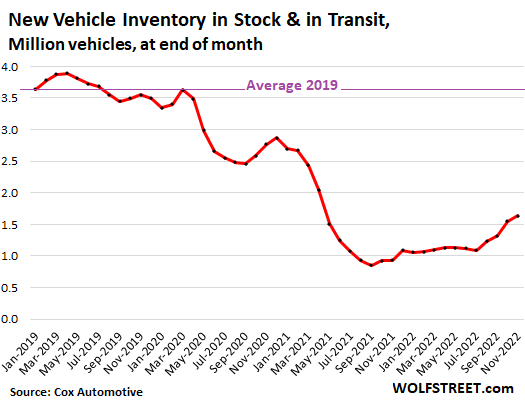
New vehicle sales were still dismal – now handicapped by a complex mix of factors, including prices that are too high, and a fairly sudden shift in demand from big vehicles such as pickup trucks, which were red hot during the pandemic, and which automakers prioritized building amid the chip shortage, to fuel-efficient vehicles, particularly cars.
These shifts were big enough to move the needle: For the 2022 model year, in terms of vehicles produced for sale in the US, the overall miles per gallon increased by 0.9 MPG, to a record of 26.4 MPG in 2022, the biggest year-over-year increase in 10 years.
And so dealers are having the wrong stuff, and it’s overpriced, and sales just cannot recover and wobble along at levels first seen in the 1970s.
In November, 1.159 million vehicles were sold, according to data from the Bureau of Economic Analysis. Though this was up by 10% from the even more dismal sales a year ago, when dealers were essentially out of stock, it’s still down by 20% from November 2019, which had already been a lousy month:
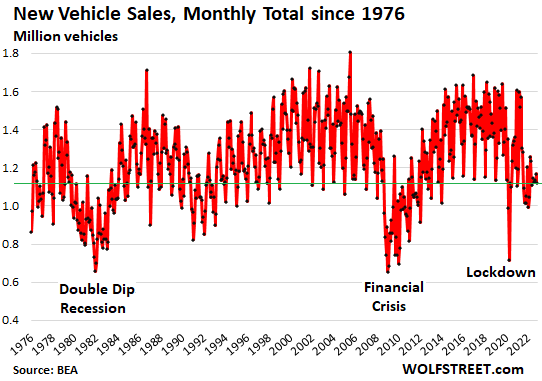
Days’ supply – due to this combination of relatively low inventories amid dismal sales – has been rising and is closing in on “healthy” levels in aggregate.
Supply at the end of November rose to 53 days, the most supply since February 2021, and double the supply in August and September 2021.
About 60 days supply is considered “healthy” in the industry. In 2019, inventory had been piling up and sales had slowed, which caused supply to average 89 days, and caused automakers to throw large-scale incentive programs at the market to move the product.
So on an aggregate basis, supply is still low but is starting to return to healthy levels. The problem now is that across some brands and models, there is nearly no supply, and across other brands and models, particularly US brands and large vehicles, there is oversupply.
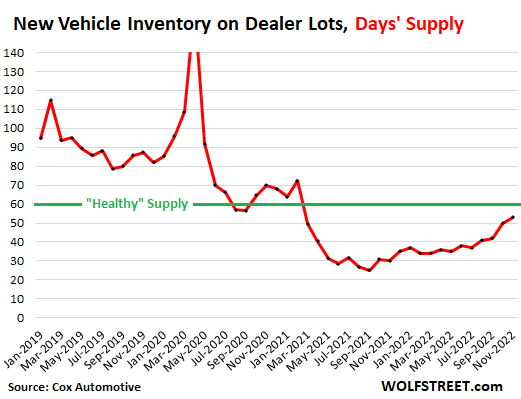
Supply by brand.
Supply varies to a very large extent by brand, but have been rising nearly across the board.
Among the non-luxury brands, Toyota and Kia had the lowest supply of 26 days (up from the 16 to 20-day range a few months ago). Honda had 34 days, Subaru 38 days.
Among the luxury brands, Lexus had the lowest supply with 26 days, followed by Land Rover (33 days) and BMW (37 days).
A whole slew of brands had over 60 days supply. Some had about 90 to 100 days, which means overstocked: Lincoln, Volvo, Jaguar, Ram, and Dodge. And three had over 100 days supply: Infiniti, Jeep, and Buick.
Tesla doesn’t have dealers and therefore doesn’t have inventory on dealer lots. And it doesn’t disclose its own inventory. So Tesla is not included here (data via Cox Automotive).
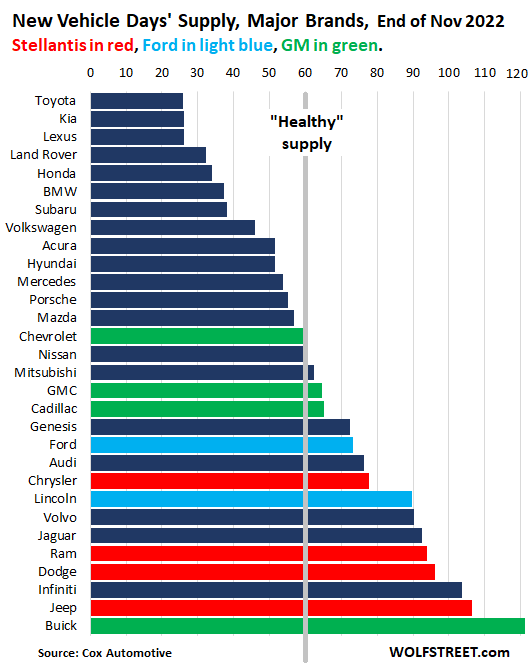
Supply by segment.
What sticks out is that the most fuel-efficient vehicle segments – compact cars, subcompact cars, and mid-size cars – have the lowest supply amid the sudden shift in demand, when gasoline prices started surging last year, while automakers were prioritizing their high-dollar big vehicles that were red-hot during the pandemic. The long and complex supply chains, which were already strained from the semiconductor shortages, could not accommodate the shift.
In an ingenious move that still baffles my mind, compact cars, subcompact cars, and mid-size cars are the segments that US brands, under intense and idiotic pressure from Wall Street, have largely abandoned over the past few years; and have handed their share to Korean and Japanese brands – most of them made at factories in the USA and Mexico. And they’re now totally dominating the segments.
Full-size pickup trucks now have 77 days supply. In that group are Ram trucks. The brand, which also makes vans, has 94 days’ supply. And it includes Dodge trucks. That brand has 96 days’ supply:
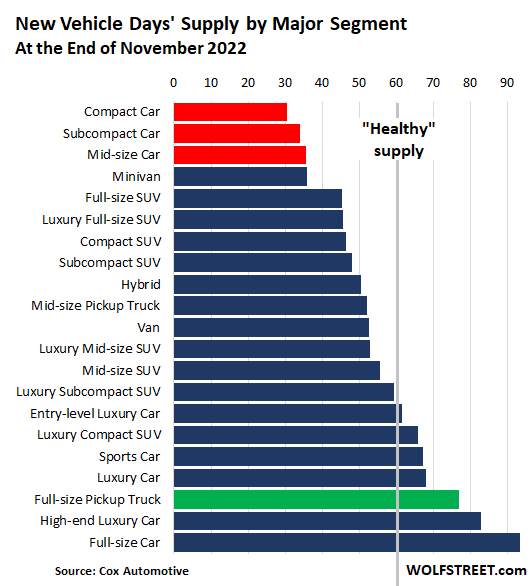
Prices are too damn high.
The average new vehicle asking price rose to a record $46,823 in November, according to Cox Automotive. But the increases have slowed from the red-hot pace last year. In November, the year-over-year increase was only 3.9%, and in October it had been 3.6%, the slowest year-over-year increases since March 2020, following a blistering price spike during the pandemic: Since February 2020, asking prices spiked by 25%:
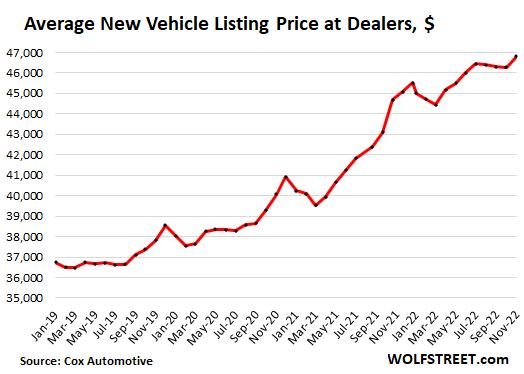
Enjoy reading WOLF STREET and want to support it? You can donate. I appreciate it immensely. Click on the mug to find out how:
![]()


The beauty of short term MBA thinking – abandon any difficult market to your competitors and give the exec’s big bonuses.
And buy back shares. The general problem is no accountability.
Why else would 10 year yield drop as Fed raises rates by 0.5%.
Don’t forget go bankrupt, have the US government bail you out but somehow forget to structure your survival so it is contingent upon long-term sustainable manufacturing choices. Are we going to see rinse, repeat during the next recession? In my dictatorship there will be a 10-year clawback rule for executive compensation for bankrupt corporations. All former executives shall be left destitute by decree.
Destitute by decree is a good turn of phrase…but you forgot to include politicians.
When the history of American ruin is written, the horrifically bad political class post 1950 will be in the forefront.
Psychotically greedy and numbingly untalented corporate executives have done plenty of damage but…DC had God’s debit card after WW 2 and still managed to destroy the economy.
…with a lot of aiding, abetting, and funding, from K Street…
may we all find a better day
As I mentioned a few days ago, Honda and Toyota both stopped selling their subcompacts in America, a few years ago. The Honda Fit is an amazing car. Fits a lot, including an eight foot ladder, and can get up to 40mpg in city driving.
I can’t comprehend the appeal of a car that costs 2-5 times as much.
Daisy…”comprehend the appeal?” I really need to take you out on a hilly countryside spin in my 4-liter naturally aspirated flat-6 Porsche sports car equipped with a six-speed manual transmission. Yes…it probably cost me 10 TIMES as much as the Honda Fit, however I promise I will altogether redefine “the appeal” for you.
To be honest, I’d rather play a game of cards. To each his own.
Cool. I’m sure you paid top dollar for the thrills. For those of us with Fits trying to get from A to B, you know, normal people, I am upset that they have been discontinued.
For me , the best vehicle is bicycle but very few people can afford to be on bicycle.
Right there with you Big Jim.
For $129k, there’s a 2020 Cayman GT4; 7K miles, 6 speed with clutch & 4 liters mid-engine at my local dealer.
I agree with Wolf, it is idiotic for the Big Three not to offer up a small or mid-sized efficient ICE car. And in many ways, the old station wagon is one of the most utilitarian of vehicles out there.
Anyone remember the 2010 BMW 535i xDrive wagon? A set of good snow tires on one, and you’re ready for this time of year in the northern Prairie, I reckon.
There is no profit in small cars. And red necks need big trucks with big wheels. US CAR manufacturers loves this red necks.
Sometimes it’s nice having a chemical imbalance and being unable to feel joy. I can’t imagine spending probably 100k dollars so I could go get a speeding ticket zipping through mountain back roads. That’s a pretty costly thrill.
That all sounds like a Big Waste of Time to me, Big Jim.
But you sound friendly. :;
These days, the “spirited” daily driver is a heavy consideration for the male automotive market. I have neither the time, justification, nor inclination to own a vehicle that doesn’t have cargo and passenger capacity, is expensive to maintain (many manufacturers make cars difficult and expensive to work on, but it’s generally agreed that Germans are among the worst in that regard), and is difficult to drive in inclement weather (3+ months a year for me). But for under $60,000, I can get a Kia Stinger or a Genesis G70 with AWD (that will fare better in the weather) and a 3.3L biturbo 6. The Stinger beat the Panamera Turbo around the Nuremburg Ring. If I want to save $10-20k, I can purchase it with a 2.0L Turbo 4.
Subaru’s WRX and various other cars have become the defacto “dad cars” of choice. The WRX is a good case study in that in 2014, they ditched the hatchback and began manufacturing it as a sedan. Prior to today, the “fast practical daily-driver” market was largely synonymous with the “hot hatch” market of Volkswagen GTI, Mitsubishi EVO, and Audi A/S3 fame. The “Everyman” of America is typically opting for a practical car that is fun to drive if he has such urges. Practical is the dominating factor for the vast majority of buyers. “Fun” is an enhancement.
Grant,
That is a very good analysis. The small to mid-sized SUV is probably the practical vehicle for most Americans.
My 10 year-old AWD mid-sized SUV, with Blizzaks as my winter tire, is the perfect machine in Minnesota during this season. And if I had to choose just one four-wheel ride to own year-round, that would be it. It does many different things quite well, and comfortably too.
I am selling my gold-plated Mercedes to the highest bidder! Let the offers begin!!!
I will bid (2.5% – cpi for March 2023) x $100 Million. If you meet your target of 2%, you get half a million. If inflation remains at 8%, you give me the Mercedes and $5.5 million.
Sold.
Cool, we will sync again when March 2023 inflation results are out.
If only we could get real Powell to pay, but the Fed is never held accountable!
what is nice to see is the amount of car manufacturers. As I remember in the 70s there were few and many foreign brands were considered bad quality.
Anyway now I think most brands can be considered decent quality.
“Anyway now I think most brands can be considered decent quality.”
I dunno about that. But, then again, I’m allergic to unintentional walking.
There was a chip shortage. New vehicles have all sorts of chips for onboard maps, GPS navigation, bluetooth hands free cell phone connections, automatic braking, lane centering, adaptive cruise control, etc. There are camera, radar and laser/lidar sensors. Automakers made more money selling higher profit margin trucks, thus they spent their computer chips on building trucks. There are still reports of chip shortages in spite of new silicon chip fabs under construction.
The problem is that new silicon fabs take a very long time to build and get in to operation. My local watering hole is filled with union tradesman working on Intel’s D1x mod3 plant ( Intels most advanced, from which all others are based) and they tell me stories of what it takes to get one of these places running. Just hooking up the supply lines ( water, chemicals, etc) to one tool takes a 5 man crew 5 weeks. Just to clean one of these places from level 1 ( where they start at end of production) to level 4 ( needed for highest grade chips) can take 6 months or more. They started building this one in 2017 and still not in production. Granted latest generation IC’s are not the same as chips in cars but the factories take almost as long to get going. It will be quite a while before any fabs started since the Pandemic go in to operation.
Bond traders pray for recession, otherwise the bond massacre will cont.
If the market fulfill their wishes Ford and GM might become zombie again.
I’ve seen this movie. So Ford, GM, and Chrysler’s small vehicles are in tight supply and Asian imports are too, and priced to perfection. But instead of taking the opportunity to take them behind the woodshed, they’ll raise prices. Me? I can’t help but think Iacocca would have gone for the jugular to gain market and mind-share. But that’s just me.
Wife and I both drive 2007. 16 years is way over the 12 year US average for holding on to a vehicle. New tires, new brakes, and fresh oil change. Todays market fetches $110k to replace what we have. I guess we’ll wait until something major breaks. Doubt the market will decline 25% anytime soon.
I had a coworker who bought a hybrid Ford sedan around August 2021. Everyone asked him why a hybrid when gas prices at that time were fairly low.
Early in 2022, the Russia-Ukraine war happened, and the coworker was the first person not to complain about gas prices.
Qatar. The whole Arab world was praying for Marocco.
Qatar, a diminishing energy hub, showing their glittering RE to the
world, using FIFA, like China in the 2008 Olympic, before their military parade. MBS and Xi, two diminishing powers, before plunging under a pile of bad debt, blaming US higher interest rates.
I hate their fans’ whistling. Glad they lost so I will not hear it Sunday.
I noticed that their was a decent available supply of Camry Hybrids at my local dealers however they still had that BS dealer adjustment fee on top of msrp. F that!
Maybe that’s why they had supply?
Wolf – thanks for the reminder that one might remember to flip one’s telescope occasionally when the image therein is hard to make out…
may we all find a better day.
Ah, let’s not forget about the completely missing segment, station wagons, the few remaining examples I’m sure are collapsed into other car categories. The taller ones are not station wagons anymore anyway, such as the Subaru Outback, although it is routinely hailed as the top selling wagon, despite it being clearly just another bland CUV.
I gripe because these are, in my opinion, the best possible vehicles to own, especially late-model ones available in the rest of the world. They drive like cars, with no suspension compromises and hold cargo like SUVs with no fuel economy penalties. It’s a shame that CAFE and vanity killed them.
I think the minivan killed the wagon.
A minivan can haul 8 people, tow 3500 pounds, or haul stuff in the cargo ares (snowblower, yard bags, or even a fridge). 20/33 mpg.
You’re probably right, in my younger years a lot of small time contractors and trades guys picked up minivans to haul tools, they were an absolute bargain over pickups and work vans. Younger guys would opt for a hatchback if they didn’t haul anything too large.
In Europe where minivans and pickups never made much of a splash the market for wagons still exists, some of them are pretty cool too with tons of power.
US average new vehicle prices $47,000 with US average household income $71,000. Something’s gotta give..
Yes. You nailed it. And if you look at the sales chart (2nd chart from the top), you will see what already gave a long time ago: sales volume.
More than that, average new vehicle price is just a little more than 10% of the average new home price. They’re both perilously out-of-whack with wages and held together by access to credit. Unfortunately for auto-manufacturers, many vehicle purchases are voluntary “upgrades.” Americans have proven they will hold their noses and pay for a new transmission when in a seller’s market for vehicles.
I just spent $770 to have a new alternator and battery installed on my car that is worth $400 bucks. I paid $52 in sales tax.
The monthly car payment on a $46,000 vehicle would finish me within two months. I currently pay $32 a month for liability insurance + gas.
Fortunately, most people make way more money than I do.
Bespoke van racking installations about doubled in price in last 12 months – in addition to new van price increases.
The high point of wiz-kid Robert McNamara’s career was ‘inventing’ the Ford Falcon.
Was it the climb in fuel prices that killed the small car inventory? Or the climb in interest rates for financing?
The smaller fuel-efficient cars also tend to be cheaper. Either rising fuel prices or rising interest rates could have killed sales. Or it could have been first one, then the other.
Emission regs killed the small car. All the same equipment required and tighter regs depending on the silhouette with none of the profits. It’s in all the old press releases from the former “big 3”
They didn’t kill the small cars from Japanese and Korean automakers. Just US automakers? US automakers abandoned entire segments of the market to foreign brands (now manufactured in the US), and they made extra room for Tesla to thrive. And now they’re 10 years behind with EVs. The stupidity of the legacy US automakers knows no bounds.
We’ve all seen this before and I’m surprised nobody has mentioned it. SUV hysteria, The Great Bubble Pop, fuel ” crisis “, and automakers be like “Who coulda knowed?” (Anyone). Cue Cash for Clunkers and other bailouts. So we’ll see how dumb automakers are. They’ll be fine as they keep spending billions per year where it matters, on media and political favor.
Anyone know if:
A1) Buyers’ Clubs like Costco are selling as Dealer/Retailer themselves;
A2) Are Costco New Vehicle Purchases fairing cheaper prices than “conventional” Dealerships?
B1) Are “Vacation Buying Directly from Automaker” Programs available Today? (Fly to Sweden, buy a Volvo, drive it around, drop off at a Port to ship to Murica, pick up shipped Volvo – possibly save €€€/$$$ if you do it by yourself or take your Spouse along).
IIRC, one buys those Cars directly from the Automakers. It would be interesting to see if such programs are active.
*****
Also,
Anyone seen CHN and VNM Vehicles being sold here in Murica yet? IIRC, several Makers are expected to start selling Models this Year. From the Promo Vids I’ve seen, some are due to undercut Murican ICE and BEV pricing as well as One Maker Selling from their Home Office while running “Service Centers” Stateside.
Buyer Beware on the CHN and VNM Imports – until there’re enough Reliability+Quality Data on each Maker and Model to see who are “doing this correctly”. I personally expect the CHN Makers Partnered with Toyota+Honda (Full Disclosure – my Cousin used to be a CEO for Toyota Subcontractor) to have the shortest “Learning Curves” to be successful in the Murican Market.
Sweet Deals.
Volvo are offering to ship their Cars to their own Dealership in Rhode Island…
Car and Driver did a Summary a few years ago
Hey, you never know. You might save a bit compared to a Murican Dealer Markup – and – score a Spring/Summer Vacation to Europe.
Expect to pay a lot more for your Fuel; but it’s cheaper than driving a Rental around…
Improved homologation regulations could bring small cars back to the US market but the companies do not seem interested in doing that.
I must live in an area that still has pent up demand for trucks. I haven’t found a dealer in my area with more than 5 or 6 half ton trucks in stock and typically even fewer heavy duty trucks. Not that I have $75K to drop on a new truck, but a fella can dream…
When you have schizophrenic energy policies, you get the same schizophrenic swings in consumer behavior. After a while everything freezes up and no one moves waiting for the next signal.
How the heck do you allocate capital in this Bizarro world?
Schizo energy policies? How many times have we heard Biden shut down the fossil fuel industry, only to see that output is humming along at the all time high? Jeez. Top line changes to policy make hardly any difference. Externalities, THOSE make a difference. You know, stuff like wars among oil/gas producers, recessions/booms, etc.
Ford Motor hikes price of F-150 Lightning; now starts at $56K, which is $15K higher than its original pricing, according to Electrek
Prices of everything that is in high demand get hiked to the point where demand fizzles. Demand for ICE pickups has slowed, so now they’re cutting prices by putting incentives on them, But there is plenty of demand for EV pickups and almost no supply. So they hike while the hiking is good.
Just out of curiosity after reading this article, I browed on cars.com for my local area for EVs for sale. There are 8 F-150 Lightnings for sale within 20 miles and 41 Mustang Mach-Es. Among the F-150 Lightnings are one with an MSRP of $73K being offered for $85K by the dealer; another with MSRP $73K for $83K, etc. So the few being sold right now are getting sold for a premium.
And most of the Mustang Mach-Es are listed for $5-10K over sticker, too.
I haven’t driven anything but American made full size cars for over 20 years — their terrible resale value has been very advantageous to me as a used car buyer who drives them into the ground.
Good Point. I drive a 25 year old Chevy Suburban with Bosch port fuel injection.. Crappy gas mileage but it is comfortable and paid for and it tows anything I want to tow. No way that it is more expensive than a new four cylinder turbo direct injection SUV. That pig V8 just lumbers along. And those hi tek SUVs are getting maybe 27 MPG highway and my suburban is getting 22 highway if I keep it at 55 and maybe 12 in town with stop and go.
Who cares? My 1936 Cord still runs perfectly. My 1999 GMC pickup is doing okay, but shifting a little weirdly. The fancy 2002 BMW 525i is running, but I have trouble with the computer warnings. I use electrical tape to cover the messages. My 1979 Covette runs well, but I hate the attention that it gets. from the clowns on the rode.